Recent Storm Damage Posts
Benefits of Professional Flood Damage Restoration Equipment for Marysville Homes
8/23/2024 (Permalink)
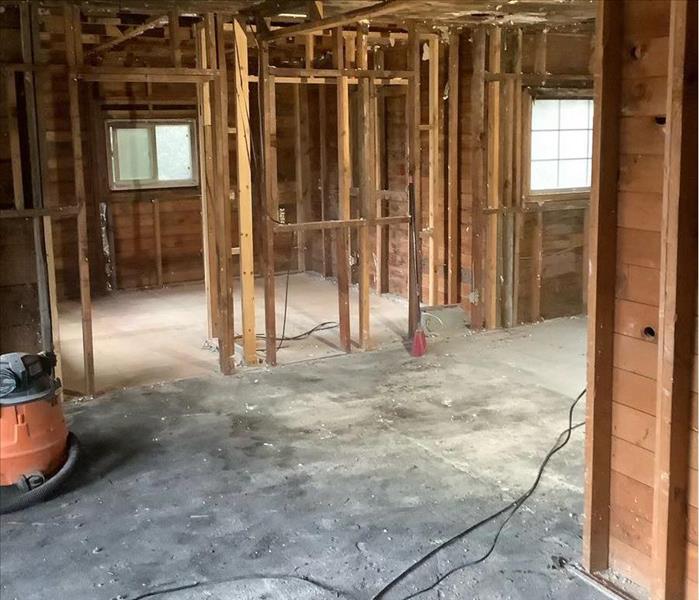 When floodwaters ruin your Marysville home, call SERVPRO®. We are Faster to any size disaster™
When floodwaters ruin your Marysville home, call SERVPRO®. We are Faster to any size disaster™
Better Outcomes Using Advanced Technology for Flood Cleanup
After the storm passes, cleanup should begin promptly. Knowing where to start reclaiming your home can feel overwhelming when floodwaters invade your property. Flood damage can ruin carpets, soak through subfloors, and even require significant wall repairs. This post will discuss how advanced equipment is essential in restoring your property and what steps are taken to mitigate flood damage effectively.
State-of-the-art equipment for Flood Cleanup
In Marysville, flood damage restoration begins with assessing the extent of the damage. Our SERVPRO of Marysville / Arlington team members use advanced moisture detection tools to identify all floodwater-affected areas. Key equipment includes:
- Moisture Meters: These devices measure the moisture levels in various materials to determine the extent of water infiltration.
- Thermal Imaging Cameras locate hidden moisture pockets within walls and floors that are invisible to the naked eye.
Drying Your Subfloor and Carpets
Floodwaters can cause extensive damage to carpets and subfloors. More than simply drying the surface is required; the moisture trapped underneath must be addressed to prevent mold growth. Here's how we handle it:
- High-Powered Air Movers: These machines increase airflow across carpets and subfloors, speeding up drying.
- Dehumidifiers: Industrial-grade dehumidifiers reduce humidity levels, extracting moisture from the air and preventing further saturation of materials.
Wall Repairs and Flood Cuts
Flood damage often affects the walls, requiring precise techniques to ensure complete drying and repair. We perform flood cuts, which involve removing the lower portion of the drywall to promote better air circulation and drying. Our process includes:
- Flood Cuts: Typically, we cut the wall 12-18 inches above the flood line to access and dry the insulation and studs.
- Air Scrubbers: These devices filter the air to remove contaminants and improve air quality during drying.
Handling flood damage in Marysville requires a combination of advanced technology and skilled SERVPRO of Marysville / Arlington professionals at (360) 658-0506. Our restoration team is always Faster to any size disaster™.
The Hazards of Flood Damage in Marysville Homes
10/29/2023 (Permalink)
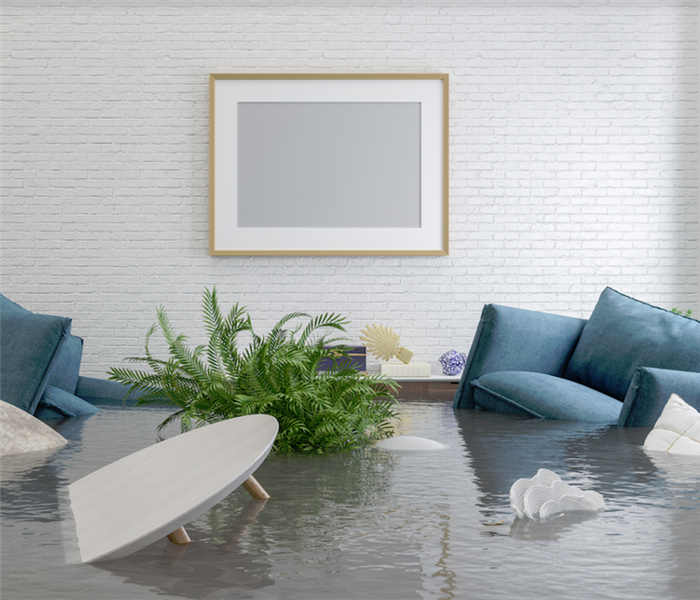 Removing water from your home is a task best left to the professionals. Contact SERVPRO 24/7 for certified technicians with professional equipment.
Removing water from your home is a task best left to the professionals. Contact SERVPRO 24/7 for certified technicians with professional equipment.
Reacting Fast to Overcome Post-Disaster Effects
Picture this - your cozy home is suddenly invaded by forceful standing water, spreading through your living space, damaging your cherished possessions and the very structure of your house. It's a nightmare scenario that can take a toll on any household. With our fast response, our IICRC-certified technicians can ensure that emergency services kick into action quickly, minimizing the damage caused by flooding and keeping your home and loved ones safe.
Overcoming Standing Water
Standing water and pooling can be among the most pressing concerns after flood damage in Marysville homes. We must remove any water collection along the flooring throughout the property and assess the effect on the structure. Extraction involves several removal tools, usually a combination of vacuums and pumps. We even have large loss equipment to manage water penetration to massive properties like the Marysville Skate Inn or the Strawberry Fields Athletic Complex.
Shock Scenarios
Excess water can pose a severe health risk when mixed with electricity. It is hazardous in places like the Tulalip Casino, where power is essential for smooth operations. When water mixes with electricity, it can trip the circuit system and act as a conductor, resulting in a significant risk of electric shock.
Weakening the Structure
Floodwater can infiltrate structural cavities and cause permanent damage to exposed materials. And, if you have an open floor plan, the spreading moisture can quickly target the most vulnerable structural elements, compromising the stability of your home. Materials include:
- Wall assemblies
- Ceilings
- Floors and subflooring
Dealing with a flood can be a stressful and overwhelming experience that poses significant health and safety risks. Our team at SERVPRO® of Marysville / Arlington is here to provide you with prompt and expert assistance. Whether it's your home or business affected, we have the skills and tools to mitigate the damage and return your property to its pre-flood condition. Don't hesitate to call us today at (360) 658-0506.
Choosing How to Dry Water Damage in Marysville Homes
4/24/2023 (Permalink)
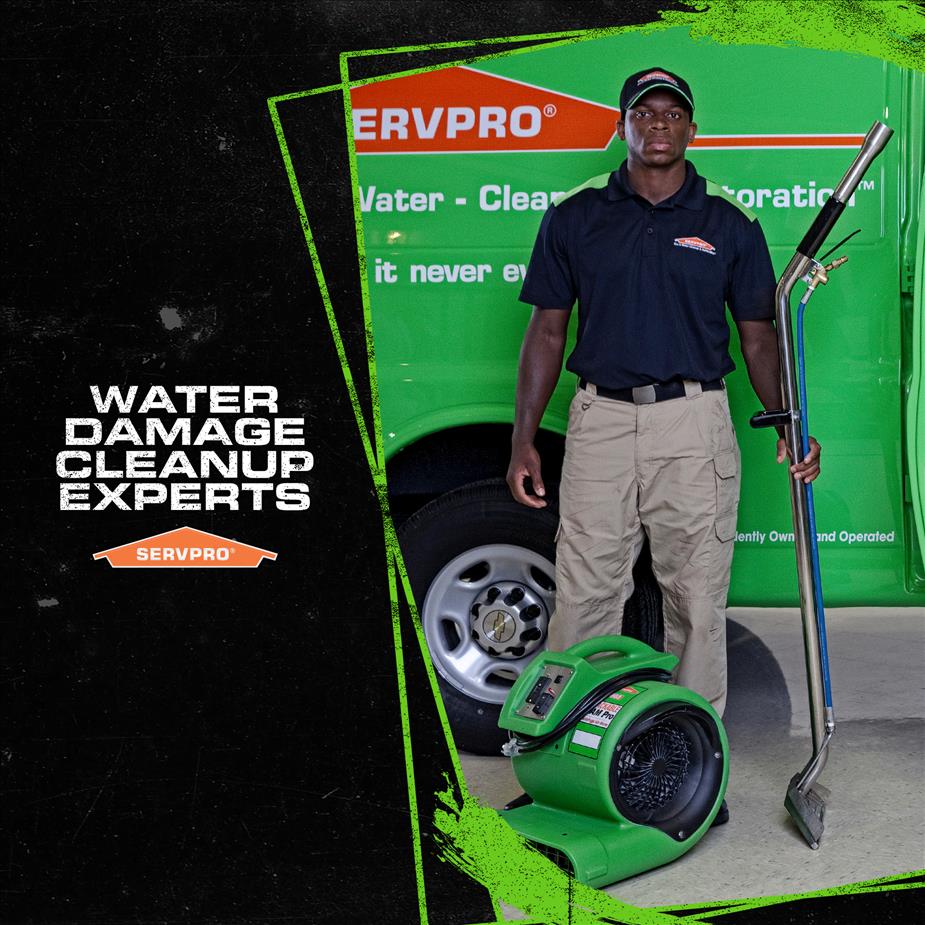 Call our SERVPRO water damage cleanup experts in Marysville 24/7. We're Faster To Any Size Disaster!
Call our SERVPRO water damage cleanup experts in Marysville 24/7. We're Faster To Any Size Disaster!
Finding the Right System Against Water Damage
While the issue of water damage might not be a new concept for our experienced SERVPRO team, managing the situation is unique. The same techniques do not work from one property to the next, at least not as efficiently. Therefore, we must evaluate the conditions of the property to choose the most effective strategies for drying your residence.
How An Open System of Drying Works
Addressing water damage in Marysville homes often uses an open drying system. This effort introduces air from outside the structure to help remove moisture and dry wet materials inside the house. This approach is helpful when conditions outside are warm and dry. However, humidity outside the home must be noticeably lower than the wet conditions inside to be effective.
There are potential issues with an open system, primarily when the external conditions are not ideal for effective drying. Some of these factors include:
- High humidity outside
- Cold air that must be heated
- Humid, cool air
The Closed System Approach
The advantage of a closed system, or manipulating the specific conditions within the house, is that we can carefully and continually monitor factors like temperature, airflow, and humidity. In addition, the drying areas are sealed and contained to ensure that the equipment involved only impacts the desired location.
To achieve this, our SERVPRO team works to establish physical containment with temporary barriers. For example, we can seal over structural openings to the wet room with polypropylene sheeting and framing to increase the impact and efficiency of portable heaters, air movers, and dehumidifiers operating in the space. We might still use existing ventilation to exhaust outside.
Clearing water damage from your home involves several techniques and approaches. Our experience and equipment allow us to manage unique situations with a custom drying strategy. Call SERVPRO of Marysville / Arlington at (360) 658-0506.
Air Mover Drying During Water Restoration in Marysville Homes
11/30/2022 (Permalink)
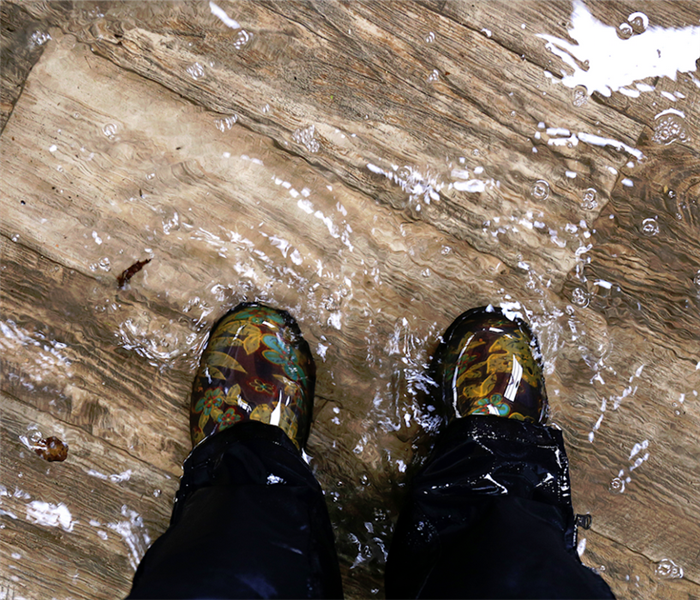 Dealing with recent flooding or other storm damage? Contact SERVPRO immediately for water removal and other remediation services. We are standing by.
Dealing with recent flooding or other storm damage? Contact SERVPRO immediately for water removal and other remediation services. We are standing by.
How Air Movers Help Residential Water Restoration
Water damage is among the most common threats to homes and businesses, so it makes sense that this is the emergency our SERVPRO team prepares most to face. Stocked trailers feature helpful tools like extractors and heaters, but most importantly, we arrive with air movers.
The Importance of Air Movers
When water restoration for Marysville homes must occur, few tools in our inventory carry the weight of this entire process like air movers. Creating a continuous and controlled airflow through the structure is one of the key elements to efficient drying and recovery. There are multiple types of high-velocity air movers in our inventory arriving with the SERVPRO Green Fleet, including:
- Axial
- Centrifugal
- Low-Profile
Overcoming Moisture Barriers
As materials dry, it is common for a cool air barrier to form several inches above the surface of this material. This is created by the moisture emitted during evaporation but creates an obstacle for continuous drying. Centrifugal air movers are designed to focus blasts of air that penetrate this cool barrier with warm air and continue to provide efficient drying results.
Increasing Production Values
Continued and stable production of the drying tools is the objective of our restoration team. We want to produce a constant drying solution wherever wet surfaces exist. We continually monitor the progress of the tools we place in the house and record data in the SERVPRO DryBook software to track this entire process. Repositioning air movers is paramount to effective and efficient evaporation.
Water restoration in Marysville is a product of dozens of drying tools and products working together towards an established recovery goal. One of the key elements in this process is the air mover. Our SERVPRO of Marysville / Arlington team will show you the efficiency of our equipment when disasters strike - call today at (360) 658-0506.
Biohazardous Materials and Asbestos Can Be Lurking in Your Marysville Home--Call SERVPRO for a Safe Cleanup and Restoration
5/29/2022 (Permalink)
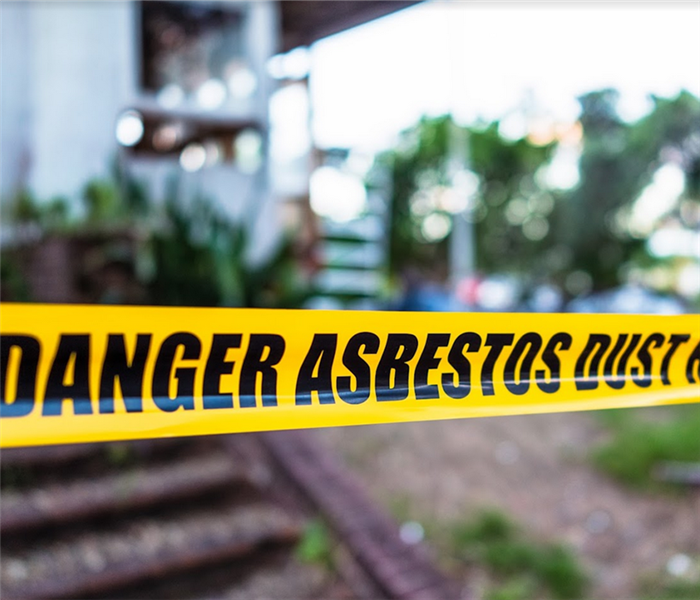 Cleaning up asbestos materials involves taking many precautions. Call in our professional SERVPRO team to mitigate your storm damage situation.
Cleaning up asbestos materials involves taking many precautions. Call in our professional SERVPRO team to mitigate your storm damage situation.
Flood Damage to Older Homes in Marysville Can Present Contamination Problems
Many older homes in Marysville were built to different standards than new homes built today. For example, the building industry used asbestos as an insulating material in walls, ceilings, and around pipes. As long as the asbestos is undisturbed, safety organizations maintain there is no danger to human health. However, once it is disturbed by renovation activities or restoration after a flood, particles of asbestos may be dislodged into the air and ingested by anyone working in the area.
SERVPRO provides flood damage restoration services in Marysville and surrounding areas. We also restore homes and commercial buildings after water leaks, storm, and fire damage. Floodwaters may also carry bio-hazards into buildings. Floodwaters absorb bio-hazard materials as the water overflows the banks of local rivers and streams. There may also be fuel and oil in the water.
Managing Asbestos Containing Materials (ACM)
The industry guideline SERVPRO follows for ACM is when asbestos is suspected, the material should not be disturbed. Do not perform work activities that could cause particles to become airborne. This includes sawing, hammering, drilling, sanding, scrubbing, or removing the material. Licensed asbestos abatement experts must remove these materials.
Biohazards
Homes built before 1960 may also contain lead-based paint, which can be harmful to humans while sanding or scraping the paint. Floodwaters may contain sewage, and other materials picked up during the flood stage. Excessive moisture in a home or building is an excellent breeding ground for bacteria, mold, and viruses.
We train our SERVPRO team members to deal with all of these potential hazards from floods. Abatement professionals may be called in for asbestos removal. Cleanup of bio-hazards must follow industry protocols for handling and disposal of waste, debris, and contaminated materials in your home. OSHA supplies very definitive guidelines for biohazard cleanups.
Avoid risking the health of your family, let the experts manage the clean up after a flood, especially when there is the possibility of asbestos or biohazard contamination.
Call SERVPRO of Marysville / Arlington at (360) 658-0506 for 24/7 service. We proudly serve Stimson Crossing, Sisco Heights, and surrounding areas. We're Faster To Any Size Disaster.
Our Technicians Are Ready 24/7 To Restore Your Marysville Home After A Flood
5/6/2022 (Permalink)
 When flooding affects your living space, a quick response is often necessary. Call SERVPRO for water removal and drying services. We are standing by.
When flooding affects your living space, a quick response is often necessary. Call SERVPRO for water removal and drying services. We are standing by.
How Does SERVPRO Handle Flood Damage to Marysville Flooring?
Flood damage is one of the hardest things that can happen to a home. The water is just one of the problems, as it comes in, it brings in a host of things such as debris, mud, chemicals, and commonly: sewage.
SERVPRO technicians know that floors get the brunt of flood damage in Marysville properties. Gravity and the path of least resistance are the rules the water follows, and once in the home, it runs down into floor joists and basements or crawl spaces.
Floodwater and Carpet
When carpet absorbs floodwater, it takes in everything present in the water, including any bacteria or toxins. Except in rare cases, SERVPRO technicians extract the water using weighted extractor heads to push the maximum amount of moisture out of the carpet and pad. This action makes the carpet safer to handle and cut it into strips for disposal as a biohazard.
Floodwater and Tile
Ceramic tile with sealed grout lines often fares the best of any other type of flooring, and it has the most potential for getting sanitized. The SERVPRO IICRC-certified techs use their portable pumps and squeegee attachments to pull up the water and prep the floor for drying.
Floodwater and Laminate Flooring
This type of flooring suffers flood damage from exposure to water. The majority of this kind of flooring loses its adhesive grip to the substrate.
Whether or not flooring has the potential for reinstallation depends on the construction materials and how they respond to cleaning and disinfection.
Floodwater and Hardwood Flooring
While hardwood flooring is an investment in a home, exposure to water can result in warping, cupping, and crowning. Composite boards tend to deteriorate rapidly after exposure to water, and in nearly every case are a loss. Floorboards constructed of hardwood may look bad, but with the specialized drying methods such as drying mats, if the cleanup begins rapidly enough, there is a good potential for restoration.
When flood damage happens, call SERVPRO of Marysville / Arlington at (360) 658-0506. The certified technicians can clean up the water with their advanced methods and equipment to make the loss, "Like it never even happened."
Be Mindful of Floodwater Damage Hazards from Arlington Storms
3/11/2022 (Permalink)
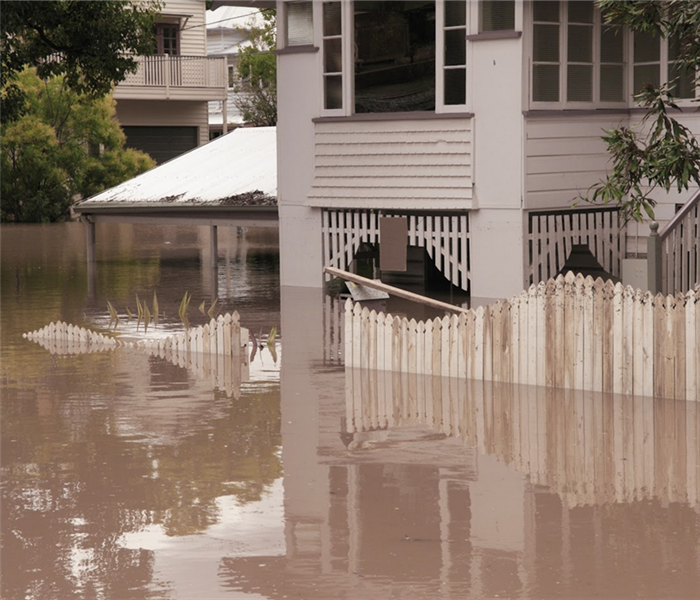 When storms result in flooding, time is of the essence. Contact our certified SERVPRO team to remediate the floodwater damage in your home. Call 24/7.
When storms result in flooding, time is of the essence. Contact our certified SERVPRO team to remediate the floodwater damage in your home. Call 24/7.
Storms in Arlington Creating Flood Water Damage Call for Prompt Action
Whenever storms are severe enough in Arlington to bring on flooding, it is essential that everyone in your home is safe. From there, you will need to remain careful when navigating any standing water within your home. SERVPRO is not only available to address any safety concerns from structural damage and saturated materials, but we also take extra precautions to ensure contamination does not become an issue in any unaffected areas of your home.
It is vital to protect yourself from coming into contact with the storm floodwater causing damage to your Arlington property. Exposure to contaminated waters may include chemicals, vermin, feces, and more. If you come into contact with floodwater, you should:
- Wash using soap and clean water as quickly as possible. Alcohol wipes or hand sanitizers are a good substitute if clean water is unavailable.
- Wash any clothes contaminated with sewage or floodwater using detergent and hot water before wearing them again.
- Always address wounds carefully and seek medical help if needed.
Due to the contamination found in most outside floodwater that comes into homes after a storm, SERVPRO works using the highest level of caution. Not only do we wear the appropriate personal protective equipment (PPE), but we also treat standing water with antimicrobials prior to beginning water removal services.
Controlled Demolition After Flooding
Most porous building materials and personal belongings require disposal after coming into contact with floodwater. Our crew proceeds with caution, carefully inspecting all areas and performing controlled demolition as needed. For example, flood cuts allow us to remove a portion of saturated drywall and its insulation. From there, we can replace it with new drywall and finish it off to make it look good as new.
When it comes to storm floodwater damage in your home, trust only the best for water removal services and restoration. SERVPRO of Marysville/Arlington can be reached by dialing (360) 658-0506 or requesting help online!
Don’t Let Flood Damage Ruin Your Marysville Property!
2/27/2022 (Permalink)
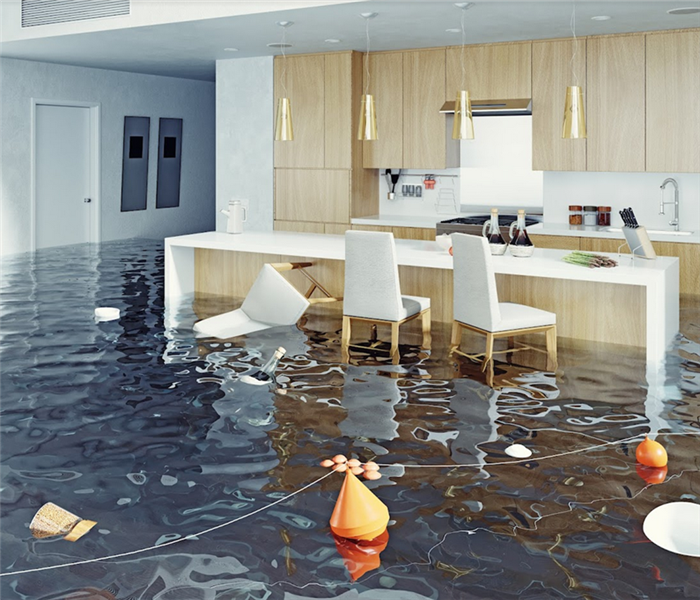 Flood damage remediation after a storm is a 24 hour a day process. Contact our certified technicians for the necessary equipment to complete the job.
Flood damage remediation after a storm is a 24 hour a day process. Contact our certified technicians for the necessary equipment to complete the job.
Call SERVPRO 24/7 in Marysville for Emergency Storm Flood Damage Restoration
When dealing with water damage from Marysville floodwaters, you need to dry out all excess moisture as soon as possible. SERVPRO’s water restoration technicians (WRT) are available 24 -hours a day, so you can feel confident you will have a team at your door and ready to get started fast. Rather than waiting for contaminated storm flooding to fester, we get there quickly to execute water removal services followed by thorough drying. We’re Faster to Any Size Disaster!
How does SERVPRO handle water and flood damage in Marysville after a storm? We bring specialized equipment to conquer several objectives as we work toward our drying goals. This includes:
- Circulating air within the impacted area to promote drying.
- Discouraging mold spores and bacteria from colonizing.
- Bring down relative humidity (RH) throughout the interior.
- Ensure temperatures remain at optimum levels for rapid drying.
- Promote efficient drying under all visible surfaces.
The benefits of hiring SERVPRO for water damage restorations are plentiful, including the professional equipment we bring within our Green Fleet. Some of the tools we may use during your flood restoration project include:
Not only does our equipment boost our restoration goals, but we also follow proven processes for successful results. We are also there to address any questions or concerns you have regarding insurance claims, how we determine what is salvageable, and the steps for controlled demolition.
SERVPRO of Marysville/Arlington is there whenever you have issues with flooding from a storm. Let us handle the damage so you can get your property back to pre-flood condition – “Like it never even happened.” You can reach us 24/7 at (360) 658-0506.
What Areas of Marysville Homes Suffer Frozen Pipes?
1/2/2022 (Permalink)
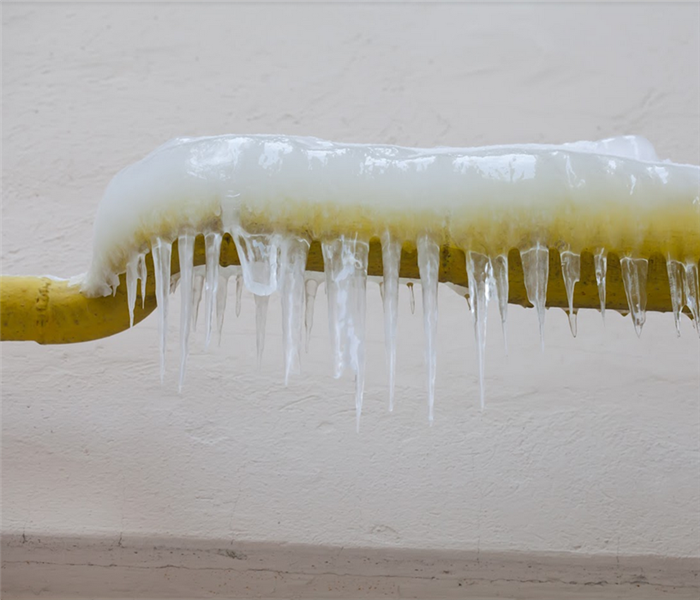 Frozen pipes can sometimes be prevented from breaking and causing damages in your home. Call our certified technicians to get more information.
Frozen pipes can sometimes be prevented from breaking and causing damages in your home. Call our certified technicians to get more information.
Frozen pipes are common enough for Marysville homeowners to actively take preventative measures.
Frozen pipes are among the most common water damage threats throughout the winter months. There are several causes of these crippling events, including:
- Temperature management
- Inadequate insulation
- Undrained unused lines
Cold Temperatures in the House
Cold snaps and harsh winter conditions can cause several damaging events like frozen pipes or ice damming in Marysville homes. One of the main causes of freezing fixtures is low temperatures in the house, which could be common when leaving your home over the winter months for a warmer climate.
Poor Circulation of Warm Air
When you have not sought warmer temperatures closer to the equator, cold temperatures in certain areas of the house can still be potentially threatening.
Improper Insulation of Pipes
Plumbing must be protected against the elements. When steep temperature drops occur, cold air surrounding the lines could rapidly impact standing water in the line to freeze it. Insulation provides a barrier to keep the temperature of water in the line above the freezing threshold.
Standing Water in Supply Lines
Another cause of pipe freezing is not draining out lines that should not remain pressurized through the winter months. Outside hose bibs, supply lines to pools, and several other types of seasonal fixtures can be inadequately constructed to withstand harsh winter conditions.
What Do You Do if a Pipe Bursts?
A pipe burst can seem overwhelming and cause rapid and substantial changes to your household. It is important to secure professionals like our IICRC-certified SERVPRO team as soon as you turn off the main supply line to the house to stop the water flow. Our professionals can arrive fast to mitigate your loss through actions like extraction and drying.
While there are several possible threats for homes and businesses throughout the winter months that could lead to water damage, few are as frequent and consistent as pipe bursts from freezing. Our SERVPRO of Marysville / Arlington team can mobilize fast for these emergencies to help when you call (360) 658-0506.
Where Does Flash Flooding Impact Marysville Homes the Most?
11/28/2021 (Permalink)
 Flooding can bring in pathogens and other debris. Contact SERVPRO for water removal and flood damage remediation services.
Flooding can bring in pathogens and other debris. Contact SERVPRO for water removal and flood damage remediation services.
Restoration after flash floods in Marysville homes starts in several common areas.
Restoring your home after flood damage begins with appreciating the damage these natural disasters can do. With a rapid-response team for storm damage and water restoration, we ensure that your home receives the appropriate mitigation efforts to help where it is needed most.
Removing Water from the Basement
When considering the impact of flash flood damage on Marysville homes and businesses, the first considered obstacle for responding technicians will be standing water. Several feet of floodwater is possible after flash flood conditions, which do not recede when they have penetrated areas like the basement of a home. Extraction services are necessary in these cases, which can include:
- Truck-mount pumps
- Trash pumps
- Wet vacuums
Resolving Structural Damage
It is not uncommon for the area homes impacted by flash flooding to experience structural damage. Infiltration into the property can often exploit penetration points and vulnerabilities in the home’s exterior. As water continually passes through, these pathways become larger and more desperately in need of repair and reconstruction. We have a general contractor license to complete build-back services where needed.
Surface Cleaning Flooring and Wall Surfaces
The floors and wall surfaces are often heavily impacted by standing flood water and moisture concerns. Contamination is always a threat when flash flooding exists, as this rapidly-developing natural disaster grabs all substances and threatening solids in its path. Our IICRC-certified technicians need to focus on the disinfection cleaning of surfaces where reconstruction and demolition are unnecessary.
There is no mistaking the severe and devastating impact of flash floods on area properties. As quickly as these situations can overwhelm a home, we respond with the same urgency to ensure that mitigation gets started and the property is as protected as possible. This begins with knowing where flash flooding will impact the house the most. Our experienced SERVPRO of Marysville / Arlington team can help 24/7 at (360) 658-0506.
Arlington Residents Cannot Wait for Flood Damage Response After a Storm
7/27/2021 (Permalink)
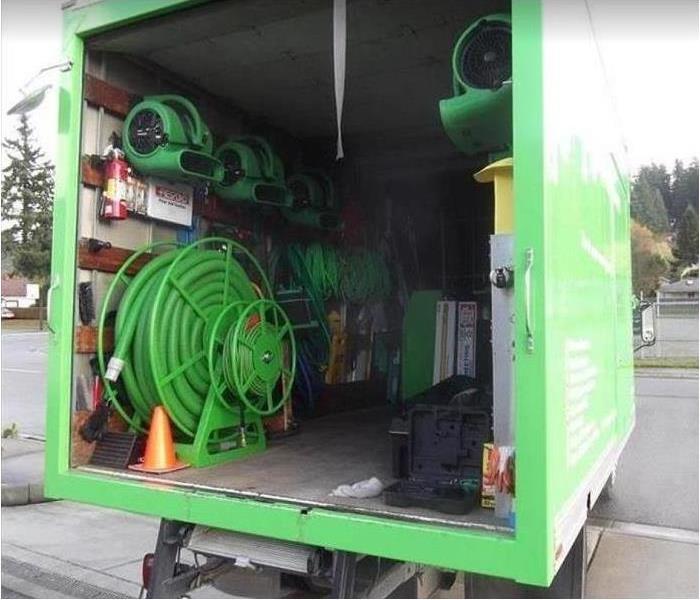 Our vehicles are stocked and ready to go! SERVPRO is available to handle your storm damage restoration needs.
Our vehicles are stocked and ready to go! SERVPRO is available to handle your storm damage restoration needs.
SERVPRO Arrives within Hours at Your Arlington Home to Begin Flood Damage Clean Up
Intense thunderstorms, heavy rain, or prolonged storms can pose a threat to your Arlington property. Storm damage comes in many forms, and you may start to see water infiltrating your garage, ceiling, or ground floor. No matter the issue, it would be best if you handled it quickly before the damage multiplied. SERVPRO is here 24/7 to address the fallout after a storm, including powerful pumps and drying equipment to make sure that your property gets left “Like it never even happened.”
Rather than trying to grab a shop vac to pull up water or trying to get out the tarps when you have a leaking roof from storms, SERVPRO has you covered. After our assessment, we will put a plan in motion that helps us bring your property back to excellent condition. This plan may include:
- Rapid water extraction
- Thorough drying
- Dehumidification to bring down the relative humidity
- Cleaning, sanitizing, and deodorization
- Controlled demolition services, as needed
Details About Interior Humidity
Our team must address relative humidity (RH) throughout your home during the water damage remediation process. Specific storm systems may also bring an increase in moisture. Once RH rises in your home, there is the potential for black mold growth. Our technicians monitor humidity and indoor air quality (IAQ) to prevent mold infestation, rot, and costly secondary damage.
Moisture detection tools play a significant role in all of our water removal services projects. Some of the technology we carry on our Green Fleet service vehicles help us to measure and monitor moisture found in:
- Furnishings
- Walls
- Flooring
- Ceilings
- Contents
Basement flooding and interior flood damage are no match for SERVPRO of Marysville/Arlington! Call us at (360) 658-0506 to have a crew dispatched to your property when you need us.
Is Content Cleaning and Relocation Important for Flood Removal in Marysville?
7/5/2021 (Permalink)
 Was your home recently flooded? Call our SERVPRO team 24/7 to arrive on the scene with equipment and expertise to tackle the job.
Was your home recently flooded? Call our SERVPRO team 24/7 to arrive on the scene with equipment and expertise to tackle the job.
Marysville Homes are Best Protected with Efficient Content Management Solutions After a Flood
Flooding can leave many of the items in your house damaged and in need of attention and cleaning. Fast-responding SERVPRO technicians of our team can evaluate the condition of contents to determine if on-site cleaning is viable. When contamination is a concern, we can select off-site recovery and restoration by our skilled professionals at our warehouse facility.
Advantages to the Pack-Out Process
Off-site cleaning after flood damage in Marysville homes has multiple advantages and benefits. In many situations, the focused cleaning and recovery practices by our SERVPRO technicians can prevent replacement. These professionals can help with:
- Surface cleaning
- Deodorization
- Disinfection
- Drying
- Safe, climate-controlled storage
The Move-Back Protocols to Protect Restored Belongings
Before SERVPRO IICRC-certified professionals can return your belongings to the restored house, some initial actions must take place. First, a thorough inspection of the affected contents is required. These items get staged in groups based on where in the house they are to get returned and evaluated for surface cleaning concerns, dryness, and odors. Passing this inspection allows these items to be loaded into Green Fleet vehicles and returned to the house.
Restoring a structure is not the only priority of responding technicians after flood damage. Protecting your personal belongings and contents of the house can happen in many ways, from on-site recovery to care in our SERVPRO of Marysville / Arlington facilities. Give us a call anytime at (360) 658-0506.
Does the Content of an Arlington Home Require Pack-Out after a Flood?
5/28/2021 (Permalink)
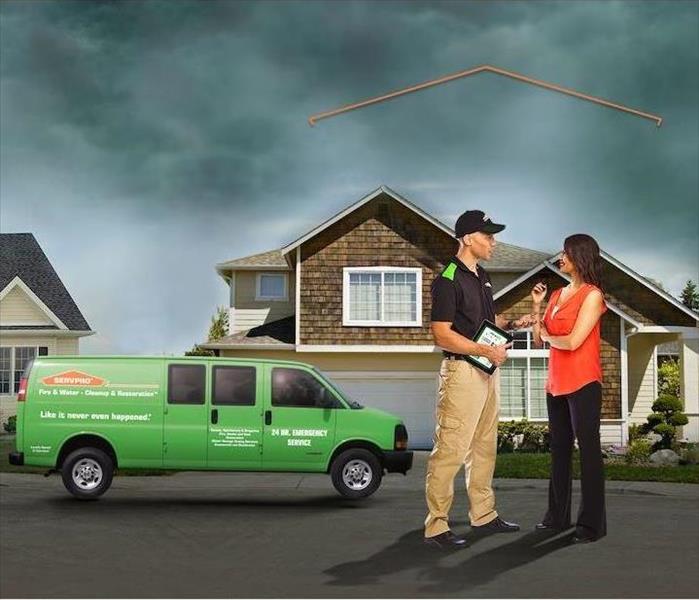 Flooding is no match for SERVPRO. We are equipped and ready at a moment's notice to restore your home.
Flooding is no match for SERVPRO. We are equipped and ready at a moment's notice to restore your home.
SERVPRO Provides Move-Out Services When Needed
When storms hit and bring with them flooding that impacts your home SERVPRO is here to provide the help you need. You might not be able to stay in your home while it gets restored, and we may have to provide move-out services.
What is a Move-Out? Or a Pack-Out?
If your home in Arlington has flood damage, intensive cleaning and restoration are going to take place. If needed, SERVPRO provides move-out services. That is where we move the customer’s contents to a secure storage location. It might include items such as furniture, clothing, or appliances. Reasons for a move-out can include:
- Quicker remodeling process
- To protect contents from additional damage
- Structural damage
- Security reasons
- Adjuster has decided it is the best course of action
- Contractors need a more favorable work site
- Content is easier to clean off-site
A move-out can be an extensive and costly process. We discuss all aspects with you and your insurance adjuster before making that decision. We typically utilize the CCIS Contents Claim Inventory System to catalog items as non-salvageable, salvageable, or questionable. All content is either tagged or scanned for security. Other services we perform include:
- Emergency services for water damage
- Water damage remediation
- Flood restoration
- Ceiling repairs from water damages
- Water removal services
- Tarping a leaking roof from storms
- Sewage cleanup
For professional flood damage services, contact SERVPRO of Marysville / Arlington at (360) 658-0506. We’re Faster To Any Size Disaster.
What Is The Best Action Plan After Flood Damage Affects My Marysville Home?
4/28/2021 (Permalink)
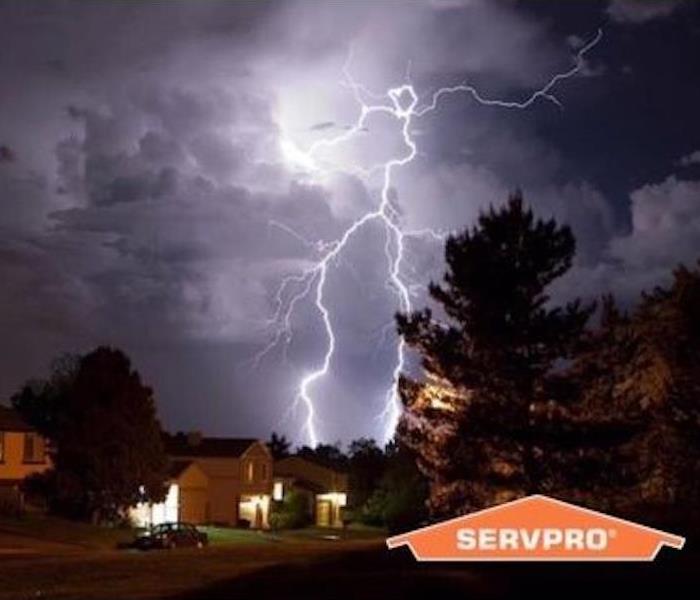 If your property suffers storm damage, call in the experts at SERVPRO for help right away.
If your property suffers storm damage, call in the experts at SERVPRO for help right away.
SERVPRO Helps Manage Underlying Issues While Delivering Water Removal Services in Marysville
On the northern edge of the Snohomish River delta lies Marysville, the second-largest city in the county, after Everett. It was established in 1872 as a trading post in the Tulalip Indian Reservation. The growth of the city over the years can be attributed to several things, including transport systems such as the Great Northern Railway line and agricultural products such as lumber and strawberry. The high number of strawberry fields in the 1920s earned it the nickname “Strawberry City.”
The topography of the area was one of the factors that favored thriving agricultural exploits. The downtown area is low, lying at only 5 feet above sea level, while the highest point near Smokey Point is 160 feet. In the early 1900s, controlled flooding of the Snohomish River allowed silt accumulation in the low lying areas, thus providing fertile soil for farming. However, as the area urbanized, the low-lying setting would lead to destructive flooding of homes and other properties.
Mountainous Surroundings
The city has unique surroundings, with three picturesque mountains dominating the views of its skyline. The Cascade Mountains and Mount Pilchuck lie to the east of the city, while Olympic Mountain stands out on the west.
For people who prefer spending time outdoors, there is no need to venture far from the city limits since there are several parks in the area, including:
The two man-made lakes formed at a site where gravel was extracted for the construction of I-5. Unlike natural water bodies, the two lakes are rectangular. In the vicinity, there is a 44-acre wooded area with picnic areas, walking trails, and a swim area.
The park and boat launch facility is relatively recent, having been launched in 2005. It was created as an intertidal marine park catering to boating needs while attracting shoppers and tourists to the downtown area.
The trail serves as a survey site for biologists at the Western Washington University but allows sightseeing. However, pets are not allowed. Since it is preserved in its natural state, it provides a great escape from the bustling city.
How Does SERVPRO Help Marysville Residents Manage Flood Damage?
Flooding incidents can be a catalyst to many problems in a home, including deep soiling or contamination, collapsing assemblies such as ceilings, and even mold. Although flooding is largely uncontrollable, how you manage the aftermath has a significant impact on the outcome.
The steps that matter most after flood damage incidents in Marysville are those that help stop further deterioration. Such deterioration can be from microbial growth processes, physical changes such as swelling or warping of materials as well as staining. Various intervention processes, including moisture management and decontamination, help improve the outcome.
Our SERVPRO teams follow established procedures such as setting up dehumidifiers within the property immediately on arrival to keep relative humidity levels below 60%. We also spray EPA-registered disinfectants in the flooded sections to control the level of contaminants. Our service combines several aspects, including:
- Flood restoration
- Water removal services
- Water damage repairs
SERVPRO of Marysville / Arlington tailors flood damage restoration to match the unique conditions of each loss site. Call us at (360) 658-0506.
Need Arlington Basement Flood Cleanup?
2/11/2021 (Permalink)
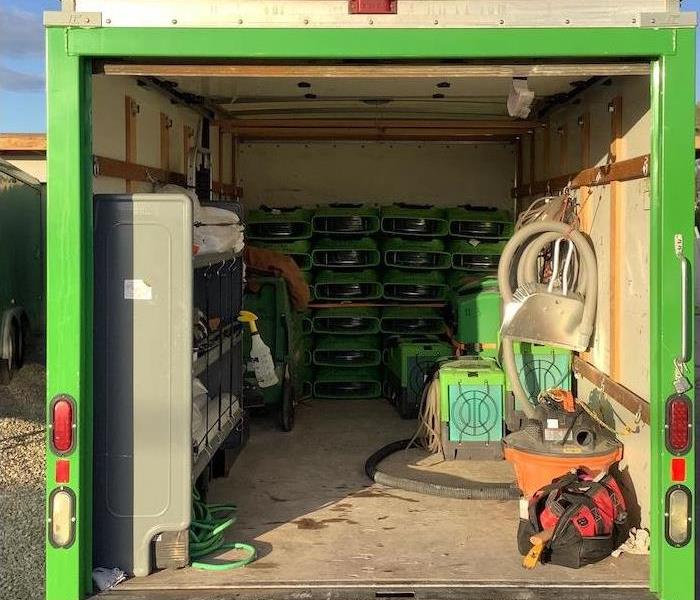 You want a trusted team of experts with the equipment your property needs after a flood incident occurs. Call SERVPRO right away.
You want a trusted team of experts with the equipment your property needs after a flood incident occurs. Call SERVPRO right away.
SERVPRO Provides Arlington Flood Damage Mitigation 24/7
Basement floods are among the most common residential disasters in the United States. A projected 98% of basements experience flood damage in their lifetimes, which can leave homes vulnerable to microbial growth, water damage, and unpleasant, lingering odors.
SERVPRO technicians offer round-the-clock basement flood damage mitigation for Arlington homeowners. Mitigation professionals undergo extensive education to perform restoration services per Institute of Inspection Cleaning and Restoration Certification (IICRC) standards.
Performing Pack-Outs for Contents Restoration
Flood damage requires a multi-pronged approach to cleanup due to the presence of floodwater debris and contaminants. SERVPRO teams can perform a pack-out, which moves your possessions to an authorized warehouse for safe storage and restoration during structural cleanup.
The move-out process entails:
- Detailed paper or digital inventories of possessions organized per room
- Some items are boxed for safety and ease of transport
- Sorting systems for salvageable and unsalvageable items
Sorting sheets categorize items by type, such as:
- Electronics
- Personal and high-value items
- Boxed items
- Large items
- Unsalvageable items
Contact SERVPRO of Marysville / Arlington at (360) 658-0506 for residential flood damage cleanup.
Port Gamble Investigations Is Hosting a Special Event Close to Arlington
1/11/2021 (Permalink)
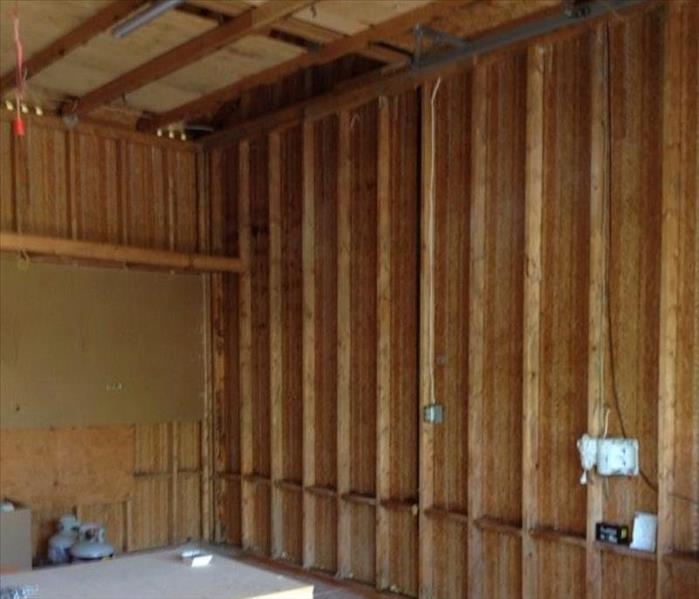 Storms can and will cause a flood. Flood damage should be mitigated by professionals. Call SERVPRO for the experience and know how.
Storms can and will cause a flood. Flood damage should be mitigated by professionals. Call SERVPRO for the experience and know how.
Flood Damage on Your Property.
There is a recent trend nationwide of people being fascinated with things that aren't proven by science. The paranormal world, including the existence of ghosts, has lately intrigued people to explore things outside of what nature seems to offer. Luckily, those hunting for ghosts can have an experience near Arlington that they are not likely to forget.
Anyone has the chance to experience a three-hour tour that is happening at the Walker-Ames House in Poulsbo. The event happens on Saturdays in January, and the next one takes place on January 23. And it is vital to remember the following when attending this event:
Wear warm clothes because the house is cold.
Feel free to bring your cameras and any paranormal investigations equipment.
The event runs from 7 p.m. to 10 p.m., and be sure to take a flashlight with you.
SERVPRO of Marysville / Arlington can help you with all of your storm or flood damage needs. Please call us at (360) 658-0506 24/7.
What Can Be Done for Flooding in a Home?
9/14/2020 (Permalink)
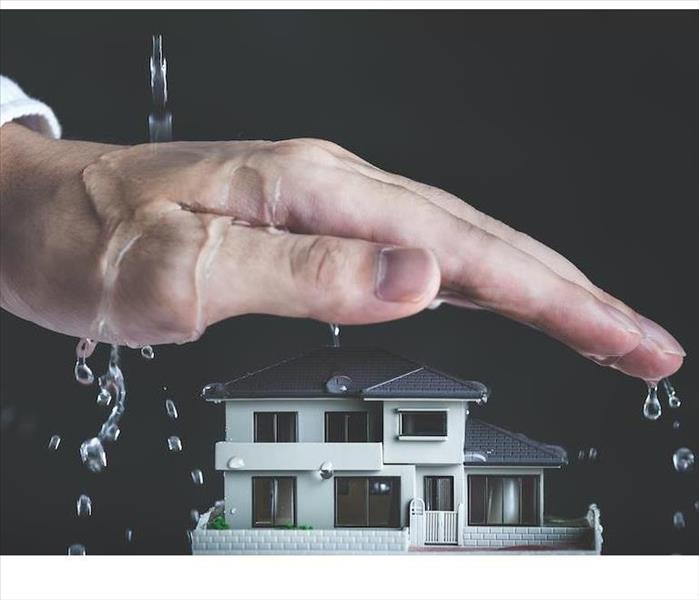 Our SERVPRO professionals are trained to handle all types of damage with the equipment and experience to restore your home to pre-damage condition.
Our SERVPRO professionals are trained to handle all types of damage with the equipment and experience to restore your home to pre-damage condition.
Calling in Trained, Experienced SERVPRO Technicians to Marysville Homes Ensures Reliable Flood Damage Restoration.
If you have ever had floodwater enter your home, you already know how difficult it can be to have it removed. In addition to the water extraction, you also need to deal with residual moisture before it leads to extensive damage. Even if you have a wet-dry vacuum to help with water removal, it is no match for the professional-grade equipment that we have at our disposal at SERVPRO. With one phone call, we can come out to your Marysville home and get started as soon as possible with expert mitigation, water extraction, and drying methods.
What Issues Do I Have to Worry About?
With any level of flood damage in Marysville, you need to know that inadequate water and moisture removal can lead to many issues. Some of the tell-tale signs that you require further restoration efforts include:
- Water stains
- Musty odors
- Buckling floorboards
- Warping or breakdown of your drywall
- Mold and mildew growth, and more
Do I Have to Worry About Water Not Readily Visible?
When it comes to floodwater removal, you cannot rely on the extraction of visible water alone. There are many cracks and crevices within your home where water may migrate, leaving behind hidden pockets of moisture. SERVPRO has various moisture detection devices that we utilize so that no damp areas go unaddressed, such as:
- Moisture sensors
- Moisture meters
- Thermo hygrometers
- Infrared camera technology
Using this advanced water restoration equipment helps minimize the loss of building materials and allows us to reach our drying goals faster. Even if the water starts to wick up inside your drywall, our skilled technicians can use our tools to determine how far the water may have traveled. From there, we can easily remove the damaged portion with controlled demolition methods.
SERVPRO of Marysville/Arlington is the crew to call when you need assistance with flood damage after a significant storm. Call (360) 658-0506, and we can send out a team as soon as possible.
What Should I Do If Sewage Enters My Marysville Home After Flood Damage?
8/30/2020 (Permalink)
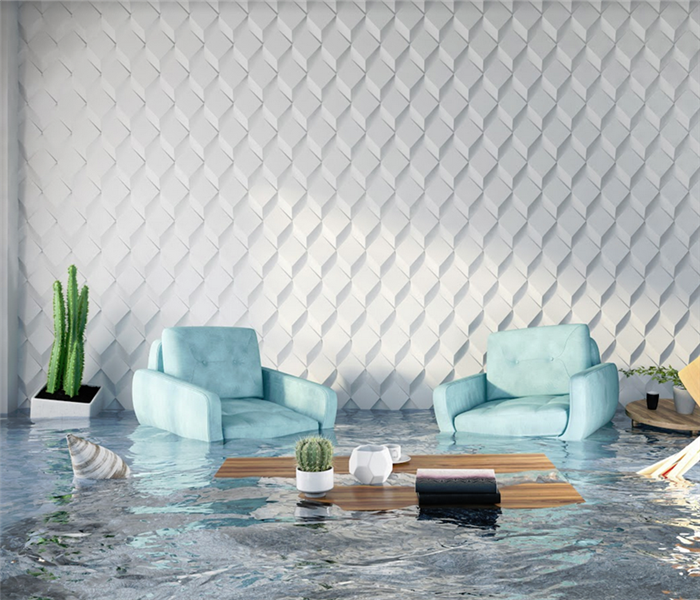 Storms can bring in water and other debris into your home. Contact SERVPRO for effective remediation services.
Storms can bring in water and other debris into your home. Contact SERVPRO for effective remediation services.
Flood Damage In Marysville Can Carry Sanitation Risks
Homeowners in Marysville know that sometimes the weather can change unexpectedly. Even with storm warnings, it is not always possible to be entirely prepared for flood damage. That is why it is essential to know which experts you can trust to help with damage remediation.
One concern for Marysville residents after flood damage is the risk of sewage flowing into the home. This is a very unpleasant thought. That is why it is helpful to know SERVPRO is on hand to help in such a situation.
How is water contamination measured?
Water contamination falls into three main categories:
- Clean water such as water from a water supply line or the faucet
- Gray water could cause harm if ingested and includes overflow from washing machines or dishwashers
- Black water is highly unsanitary and could cause damage or even death if ingested, and includes sewer overflows or standing water that has microbial growth
SERVPRO of Marysville / Arlington will test the water overflow in your home and assess which category it is (water containing sewage is classed as black water.)
What contaminants does sewage contain?
Sewage can contain several harmful contaminants, such as:
- Viruses, which can grow, multiply, and cause diseases in humans
- Bacteria, which can overcome the immune system and produce a range of illnesses
- Parasites which require another organism to live, and can cause severe digestive issues
These are all classed as bio pollutants – microscopic living organisms that can pollute air or water. Damage from sewage-infested water can also promote mold spore growth, causing further contamination and adding the risk of mold-related health effects.
Is it safe to clean up sewage myself?
SERVPRO strongly recommends that you do not attempt to clean up sewage-contaminated water by yourself. There are many potential health risks when dealing with black water. That is why it is best to call us as quickly as possible – we’re Faster To Any Size Disaster.
We put each of our technicians through rigorous training at our central training facility. We bring our staff up to speed on the latest industry-standard safety guidelines and protocols for dealing with any situation they might encounter. Our teams have the equipment and knowledge to handle black water while minimizing risks.
As well as thorough training, we equip our teams with all the personal protective equipment (PPE) they need to ensure their safety as they clean up your home. We thoroughly disinfect reusable items such as pumps and air scrubbers.
How can SERVPRO help with flood damage?
We train our remediation specialists to quickly assess the state of your home and the category of water so that they can draw up an appropriate plan of action.
Once they have completed their assessment, our team will set to work removing water from your home. We have a range of extraction tools at our disposal, including truck-mounted and free-standing pumps, and smaller carpet wands and rotary extractors. Thorough extraction is a must – the less water left in your home, the lower the risk of mold growth.
We also set up containment around the sewage-infected area. In some cases, containment is as simple as a plastic barrier or bagging up damaged items. In more severe cases, we may need to set up a decontamination area beside our workspace. This is a dedicated area for decontaminating workers, bagged materials, and SERVPRO equipment.
Our teams also take care of cleaning and disinfecting your home and any salvageable items.
When we have evacuated water and cleaned, it is time to dry your home. Drying is a vital part of the process because it makes it more difficult for mold to grow and reduces the risk of spore growth. We use a range of air movers and dehumidifiers to dry your house. We also use equipment such as moisture meters and thermal-hygrometers to monitor the drying process and ensure it is successful.
What about repairs and odors?
Sometimes after flood damage in Marysville, your home needs repairs. For example, wet drywall might need to be removed and replaced, or a wall might need repainting. Your wiring might need attention, or a fallen-in ceiling or roof could present a health hazard. Our teams carry out repairs to restore your home, “Like it never even happened.”
We also know that your home does not feel like your own if it smells musty or unpleasant. Our teams carry out thorough deodorization before project closure. We use air scrubbers and foggers to remove odors and leave your home fresh.
The thought of sewage entering your home after flood damage is distressing. However, we are on hand to remedy the situation, and we are here for you 24 hours a day, 7 days a week. Call SERVPRO of Marysville / Arlington at (360) 658-0506.
Will Exposure to Floodwater Destroy My Hardwood Flooring in My Marysville Home?
7/18/2020 (Permalink)
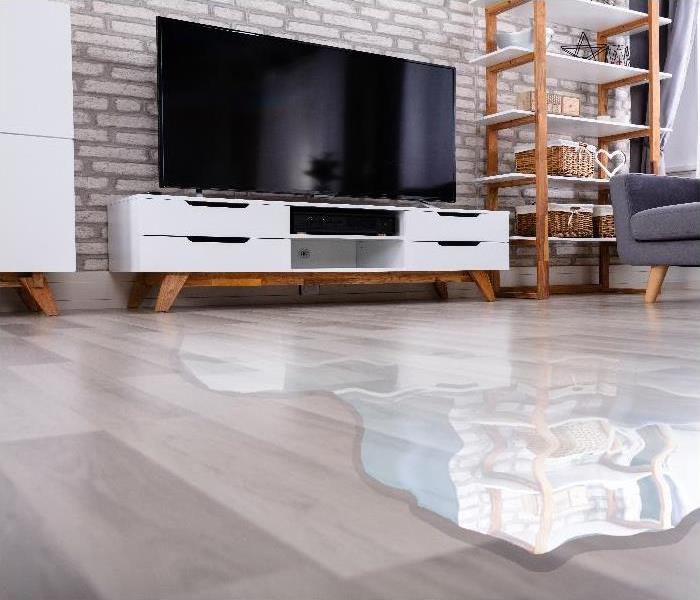 The techs have advanced equipment and techniques to restore your home rapidly.
The techs have advanced equipment and techniques to restore your home rapidly.
SERVPRO techs can remove flood damage from local Marysville properties and assist with restoration services
When floodwater rolls into a Marysville property, quick cleanup is crucial. Once the water enters the home, it migrates rapidly. Although it may recede just as quickly, the residual moisture levels can cause a large amount of loss unless it gets addressed with the proper measures to remove the moisture and dry the structure.
Can Hardwood Flooring Get Restored After Flood Damage?
The materials used to construct the hardwood flooring in your Marysville home, determine its restoration potential after flood damage also these factors:
• Length of water exposure
• If the flooring is hardwood or composite
• Evidence of mold infestation
If the water gets extracted soon after the initial exposure, the possibility exists that solid hardwood floorboards may have restoration potential. The techs may need to pull up the boards and dry them in another area if the detection equipment shows seepage into the subfloor or between floors.
Whenever possible, the techs try to dry hardwood flooring in place. This part of the restoration gets accomplished through the use of:
• Air movers
• Dehumidifiers
• Drying mats
The drying process gets monitored closely to ensure that the present drying goals get attained in the set time frame. If the techs notice the room is not drying quickly enough to stay on track, they adjust the number of drying equipment pieces deployed accordingly to keep the drying phase within the time perimeters previously set.
After water damage occurs in a home, the techs pay special attention to the early signs of mold spore germination and colony development. After the drying phase, SERVPRO techs wipe down all affected surfaces with professional-grade cleaning agents that hinder the growth of mold with antimicrobial properties.
Call SERVPRO of Marysville / Arlington at (360) 658-0506 when you need assistance for flood damage cleanup. The techs have advanced equipment and techniques to restore your home rapidly.
Do I Have to Tear Out My Hardwood Floor After Flood Damage in Marysville?
6/17/2020 (Permalink)
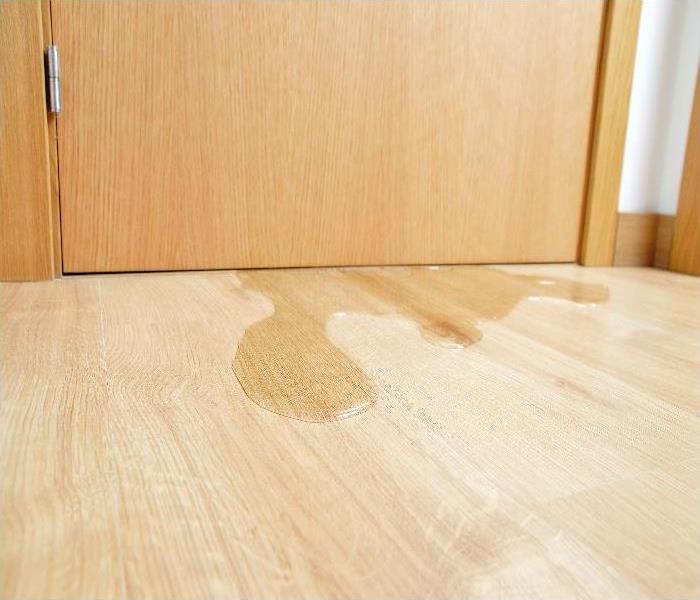 Call us at (360) 658-0506 to set up an assessment that can result in saved hardwood floors.
Call us at (360) 658-0506 to set up an assessment that can result in saved hardwood floors.
Rapid Water Removal and Professional Structural Drying by the SERVPRO Team Can Change to Course of Flood Damage for Residents of Marysville
Hardwood floors are preferred by many homeowners in Marysville, warm and elegant looking. Dress them up with a beautiful area rug, or uncover and let them gleam. If storm damage causes roof failure and allows a tsunami of rainwater to spread across your floors, all is not lost. Our technicians learn strategies and arrive with equipment that can save your hardwood from the flooding following severe storms.
How Can Flood Water Damage Your Hardwood Floors?
The surface of hardwood planks or strips often can shrug off water for a time because of the density of the wood and the finish applied to the visible top. Sides and the bottom of the strips or planks are unfinished and can absorb moisture from a wet subfloor. The hardwood then distorts, cupping or crowning, and sometimes buckling, which is a severe response, the top layer pulling entirely away from the subfloor.
Where Did the Water Come From and How Can We Remove It?
When storm water pours into your Marysville home, it percolates through the cracks in the hardwood to soak the subfloor, typically made of permeable plywood. This water load must be eliminated, or the hardwood will continuously wick up the fluid. To evacuate the water:
• Wanded extractors and squeegees move across the surface until all standing water is gone
• Negative air pressure systems suction water from more than one layer of flooring, gaining access through the use of floor mats adhered to the floor and attached to hoses that use powerful extractors to pull water up and out
The team at SERVPRO of Marysville / Arlington uses non-invasive strategies to remove water from several floor layers and then moves to efficient drying techniques that bring moisture levels in the hardwood to normal. Call us at (360) 658-0506 to set up an assessment that can result in saved hardwood floors.
Choosing the Correct Water Extraction Company for Floodwater Removal in Marysville, WA
5/3/2020 (Permalink)
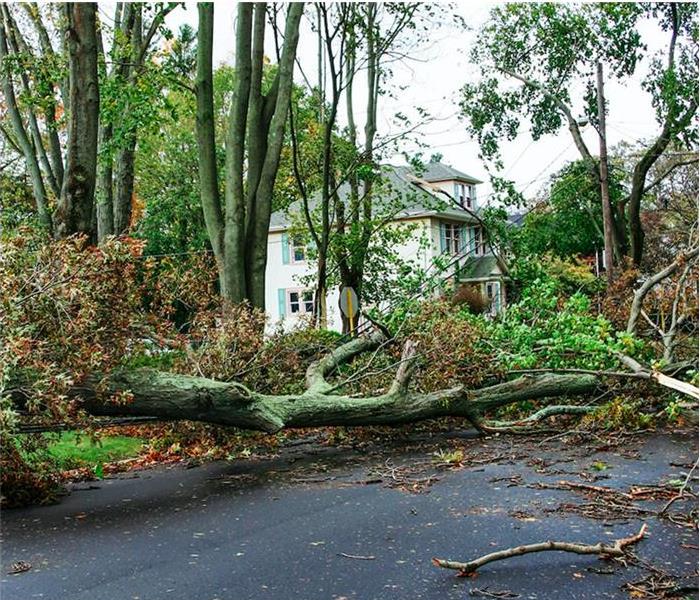 SERVPRO of Marysville / Arlington is ready 24/7 to help members of our community recover from flooding and storm damage.
SERVPRO of Marysville / Arlington is ready 24/7 to help members of our community recover from flooding and storm damage.
Flood and Storm Damage in Marysville Needs Expert Attention
High winds, lightning, thunder, and torrential rains have targeted Marysville in the past. As extreme weather patterns develop over the Pacific, communities along the inner coastlines of Washington struggle with the onslaught of severe weather energized by a storm front’s travel over the sea’s warming waters. Intense storms, including “microbursts” that dump several inches of water in a short time over a localized area, can cause residential flooding and other harm near Possession Sound.
Fast Storm Damage Response
When flooding and storm damage strike your Marysville residence, a company that quickly can provide professional mitigation and remediation is essential. We can help you stabilize and secure the exterior damage to your home. Then we assess the flooding situation, devising a comprehensive plan to remove the water, sanitize the affected spaces, and dry everything out.
Property Stabilization
If your roof shingles tore off or a falling tree broke windows or damaged siding during the storm, the SERVPRO crew use boards and tarps to prevent further harm from wind or rain. Then we begin water removal tasks. Speed is crucial as mold damage is possible if excess water remains more than 24 to 48 hours.
Professional Water Removal Equipment
Submersible pumps are the choice for more than two inches of water. When the level falls lower, truck-mounted extractors finish suctioning up the remaining standing water. Because flood water is always considered contaminated, our SERVPRO employees contain the water collected for appropriate disposal following local regulations.
Moisture Monitoring to Ensure Efficient Drying
Thermal scanners and moisture meters help us trace the migration path of any water that seeped into building cavities. If necessary, controlled demolition strategies like flood cuts provide our technicians access to remove the water and prepare for drying.
Disinfection and Cleaning
SERVPRO employs EPA-registered cleaners and disinfectants to clear up the soiling left behind by the dirty water and to sanitize surfaces. We then roll high-efficiency air movers, heaters, and dehumidifiers to facilitate structural drying. The moisture data collected throughout the removal phase and later helps us determine and meet our drying goals.
SERVPRO of Marysville / Arlington is ready 24/7 to help members of our community recover from flooding and storm damage. Call us at (360) 658-0506 day or night to request an assessment by our Institute of Inspection, Cleaning and Restoration Certification (IICRC)-trained team.
Click here to learn more about Marysville.
We Discuss The Equipment Used During Our Restoration Process In Marysville
9/20/2019 (Permalink)
 Give us a call anytime at (360) 658-0506.
Give us a call anytime at (360) 658-0506.
Weighted Extractors Can Preserve Marysville Saturated Carpeting
Carpeting can become a quickly damaged element in your Marysville home when flooding begins. Even without widespread damage to contend with, your carpets can absorb moisture and small amounts of spreading water to soak through to subflooring and even joists and supports below. Protecting both your carpets and these structural supports involves a fast response and the employment of useful extraction tools specific to this scenario.
Our SERVPRO team has invested in our inventory of recovery tools and in the training of our growing roster of local talent to overcome water and flood damage in Marysville homes as it happens. We keep production trailers stocked with extraction tools and drying implements that far exceed what you might expect. While we can provide portable pumps and even truck-mount extractors that arrive with the Green Fleet, another useful tool is the weighted extraction rigs that we roll out in damaged homes.
Weighted extractors are a specialty unit that our SERVPRO professionals use to force moisture to the surface of your carpeting. With remote controlling, we can better ensure that the entire affected area gets this moisture removal effort. The weight of the unit rolls over carpeting and subflooring materials to force water and moisture to the surface for an onboard vacuum to collect.
Depending on the type of flooding that your home contends with, you might not see the weighted extraction tool at all. Our team must determine contamination levels and whether it benefits our customer and the overall restoration of the home to remove damaged portions of carpeting and padding to better dry out and disinfect the subflooring, supports, and framework. If this flooring gets removed, we focus most on the use of our air movers and dehumidification units to collectively force moisture into the environment and collect it for removal.
As much as we always seek to preserve before replacing, this is not always a practical approach when flooding has damaged portions of carpeted floors. Our SERVPRO of Marysville / Arlington team has effective strategies and efficient tools to save our customers time and money on mitigation and restoration work. Give us a call anytime at (360) 658-0506.
For more about Marysville click here.
How To Survive Severe Storms
12/16/2018 (Permalink)
What to do during a severe storms
- If you are indoors, stay away from windows, doors and fireplaces.
- You may want to go to the sheltered area that you and your family chose for your emergency plan.
- If you are advised by officials to evacuate, do so. Take your emergency kit with you.
- You can use a cellular telephone during a severe storm, but it's not safe to use a land-line telephone.
- Never go out in a boat during a storm. If you are on the water and you see bad weather approaching, head for shore immediately. Always check the marine forecast before leaving for a day of boating and listen to weather reports during your cruise.
- If you are in a car, stop the car away from trees or power lines that might fall on you). Stay there.
What to do during
Blizzards
- When a winter storm hits, stay indoors. If you must go outside, dress for the weather. Outer clothing should be tightly woven and water-repellent. The jacket should have a hood. Wear mittens - they are warmer than gloves - and a hat, as large portion of body heat is lost through the head.
- In wide-open areas, visibility can be virtually zero during heavy blowing snow or a blizzard. You can easily lose your way. If a blizzard strikes, do not try to walk to another building unless there is a rope to guide you or something you can follow.
- If you must travel during a winter storm, do so during the day and let someone know your route and arrival time.
- If your car gets stuck in a blizzard or snowstorm, remain calm and stay in your car. Allow fresh air in your car by opening the window slightly on the sheltered side - away from the wind. You can run the car engine about 10 minutes every half-hour if the exhaust system is working well. Beware of exhaust fumes and check the exhaust pipe periodically to make sure it is not blocked with snow. Remember: you can't smell potentially fatal carbon monoxide fumes.
- To keep your hands and feet warm, exercise them periodically. In general, it is a good idea to keep moving to avoid falling asleep. If you do try to shovel the snow from around your car, avoid overexerting yourself.
- Overexertion in the bitter cold can cause death as a result of sweating or a heart attack.
- Keep watch for traffic or searchers.
Hail
- Take cover when hail begins to fall. Do not go out to cover plants, cars or garden furniture or to rescue animals. Hail comes down at great speed, especially when accompanied by high winds. Although no one in Canada has ever been killed by hail, people have been seriously injured by it.
- When a hailstorm hits, stay indoors, and keep yourself and your pets away from windows, glass doors and skylights which can shatter if hit by hailstones. Avoid using the telephone during a storm, and do not touch metal objects like stoves, radiators, metal pipes, and sinks.
- When a hailstorm hits, find shelter and avoid underpasses or any low lying areas that may flood.
Ice storms
- Ice from freezing rain accumulates on branches, power lines and buildings. If you must go outside when a significant amount of ice has accumulated, pay attention to branches or wires that could break due to the weight of the ice and fall on you. Ice sheets could also do the same.
- Never touch power lines. A hanging power line could be charged (live) and you would run the risk of electrocution. Remember also that ice, branches or power lines can continue to break and fall for several hours after the end of the precipitation.
- When freezing rain is forecast, avoid driving. Even a small amount of freezing rain can make roads extremely slippery. Wait several hours after freezing rain ends so that road maintenance crews have enough time to spread sand or salt on icy roads.
- Rapid onsets of freezing rain combined with the risks of blizzards increase the chances for extreme hypothermia. If you live on a farm, move livestock promptly to shelter where feed is available. Forage is often temporarily inaccessible during and immediately after ice storms. Animal reactions to ice storms are similar to that of blizzards.
Lightning
- Always take shelter during a lightning storm.
- There is no safe place outside during a thunderstorm. Safe shelter can be found either in an enclosed building or a hard-topped vehicle.
- If you can see lightning or hear thunder, you are in danger of being hit. Seek shelter immediately.
- Wait 30 minutes after the last lightning strike in a severe storm before venturing outside again.
- Do not ride bicycles, motorcycles, tractors, or golf carts. These will not protect you from a lightning strike.
Thunderstorms
- During thunderstorms, you should also stay away from items that conduct electricity, such as corded telephones, appliances, sinks, bathtubs, radiators and metal pipes.
Floodwater After A Disaster Or Storm
12/13/2018 (Permalink)
Don’t drive in flooded areas — turn around, don’t drown!
Floodwater can pose a drowning risk for everyone— regardless of their ability to swim. Swiftly moving shallow water can be deadly, and even shallow standing water can be dangerous for small children.
- Always follow warnings about flooded roads.
- Don’t drive in flooded areas—cars or other vehicles won’t protect you from floodwaters. They can be swept away or may stall in moving water.
Stay out of floodwater.
Floodwaters contain many things that may harm health. We don’t know exactly what is in floodwater at any given point in time. Floodwater can contain:
- Downed power lines
- Human and livestock waste
- Household, medical, and industrial hazardous waste (chemical, biological, and radiological)
- Coal ash waste that can contain carcinogenic compounds such as arsenic, chromium, and mercury
- Other contaminants that can lead to illness
- Physical objects such as lumber, vehicles, and debris
- Wild or stray animals such as rodents and snakes
Exposure to contaminated floodwater can cause:
- Wound infections
- Skin rash
- Gastrointestinal illness
- Tetanus
- Leptospirosis (not common)
It is important to protect yourself from exposure to floodwater regardless of the source of contamination. The best way to protect yourself is to stay out of the water.
If you come in contact with floodwater:
- Wash the area with soap and clean water as soon as possible. If you don’t have soap or water, use alcohol-based wipes or sanitizer.
- Take care of wounds and seek medical attention if necessary.
- Wash clothes contaminated with flood or sewage water in hot water and detergent before reusing them.
If you must enter floodwater, wear rubber boots, rubber gloves, and goggles.
Prevent injuries.
Floodwater may contain sharp objects, such as glass or metal fragments, that can cause injury and lead to infection. Prompt first aid can help heal small wounds and prevent infection.
If you receive a puncture wound or a wound contaminated with feces, soil, or saliva, have a health care professional determine whether a tetanus booster is necessary based on individual records.
For more information, visit: Emergency Wound Care After a Natural Disaster
Prevent infection of open wounds and rashes.
Open wounds and rashes exposed to floodwater can become infected. Vibrios, for example, are naturally occurring bacteria that live in certain coastal waters and can cause skin infections when an open wound is exposed to them. This can happen during floods. To protect yourself and your family:
- Avoid exposure to floodwater if you have an open wound.
- Cover clean, open wounds with a waterproof bandage to reduce chance of infection.
- Keep open wounds as clean as possible by washing well with soap and clean water.
- If a wound develops redness, swelling, or oozing, seek immediate medical attention.
Seek medical attention as soon as possible if:
- There is a foreign object (soil, wood, metal, or other objects) embedded in the wound;
- The wound is at special risk of infection (such as a dog bite or a puncture by a dirty object);
- An old wound shows signs of becoming infected (increased pain and soreness, swelling, redness, draining, or you develop a fever).
For more information, visit: Emergency Wound Care After a Natural Disaster
Protect yourself and your loved ones from diarrheal diseases.
Be aware that floodwater may contain sewage, and eating or drinking anything contaminated by floodwater can cause diarrheal disease (such as E. coli or Salmonella infection). To protect yourself and your family:
- Wash your hands after contact with floodwater. Also be sure to wash children’s hands with soap and water often and always before meals.
- Do not allow children to play in floodwater areas.
- Do not allow children to play with toys that have been contaminated by floodwater and have not been disinfected.
- Do not bathe in water that may be contaminated with sewage or toxic chemicals. This includes rivers, streams, or lakes that are contaminated by floodwater.
For more information, visit:
Protect yourself from animal and insect bites.
Floodwater can displace animals, insects, and reptiles. To protect yourself and your family, be alert and avoid contact.
For more information, visit: Protect Yourself from Animal- and Insect-Related Hazards After a Disaster
Be aware of possible chemicals in floodwater.
Floods can cause containers of chemicals to move from their normal storage spots.
- Don’t attempt to move propane tanks you might find— they’re dangerous and can cause a fire or explosion. If you find any, contact the police, fire department, or your State Fire Marshal’s office immediately.
- Be extremely careful when removing car batteries. Even if they are in floodwater, car batteries may still have an electrical charge. Use insulated gloves and avoid coming in contact with any acid that may have spilled from the damaged car battery.
For more information, visit:
Avoid electrical hazards inside or outside your home.
After a hurricane, flood or other natural disaster you need to be careful to avoid electrical hazards both in your home and elsewhere.
- Shut off electrical power and natural gas or propane tanks in your home to avoid fire, electrocution, or explosions.
- NEVER touch a fallen power line. Call the power company to report fallen power lines. Avoid contact with overhead power lines during cleanup and other activities.
- Do not drive through standing water if downed power lines are in the water.
- If you believe someone has been electrocuted, call or have someone else call 911 or emergency medical help.
For more information, visit: Protect Yourself and Others From Electrical Hazards After a Disaster
https://www.cdc.gov/disasters/floods/floodsafety.html
What To Do In A Storm
12/12/2018 (Permalink)
What to do in a storm
There are a number of things that you can do to make sure you and your property stay safe during storms. For life-threatening emergencies call 911.What to do before the storm
Ensure you do the following before a severe storm arrives:
- Check that loose items such as outdoor settings, umbrellas and trampolines are safely secured.
- If it is safe to do so, check gutters, downpipes and drains are not blocked.
- Park your car undercover and away from trees.
What to do during the storm
Ensure you do the following during a severe storm:
- Stay indoors and away from windows.
- If outdoors, shelter away from drains, gutters, creeks and waterways.
- Be prepared for power outages.
- Floodwater is dangerous – never drive, walk or ride through floodwater.
- Floodwater is toxic – never play or swim in floodwater.
What to do after the storm
Ensure you do the following after a severe storm:
- Check your home and property for damage.
- Keep clear of damaged buildings, powerlines and trees.
- Be aware of road hazards such as floodwater, debris and damaged roads or bridges.
- Do not drive through affected areas unless it is necessary.
How To Prepare For The Next Big Storm
12/11/2018 (Permalink)
Damage from a neighbor’s tree is usually covered by your insurer, not your neighbor’s.
Cover windows properly. Experts used to recommend taping windows to limit breakage to a few large pieces, rather than many smaller ones. But small and large pieces can be equally deadly. A safer bet: Keep windows shut and close blinds, shades, and drapes. Longer-term, consider impact-resistant windows or hurricane shutters (about $40 per square foot), which might also net you an insurance discount.
Secure outdoor items. High winds can turn lawn chairs, potted plants, trash cans, and other outdoor items into deadly projectiles. Move whatever you can into a garage, a shed, or a basement.
Park cars on high ground. Two feet of floodwater can carry a car away. What’s more, driving in water just 8 inches deep can ruin the engine if the water seeps in through the air intake. Park at a high elevation or on a hill—but not beneath trees.
Protect your valuables. Move what you can to higher floors if you expect flooding. Also think ahead by documenting and photographing items you’d include in an insurance claim if lost or ruined.
Stock up on essentials
Build an emergency kit. It should have a whistle to attract help, dust masks, duct tape, a wrench or pliers to turn off water if needed, flashlights and batteries, and local maps. Plan on 1 gallon of water per person per day for at least three days. Include moist towelettes, garbage bags, and plastic ties for personal sanitation. Also consider changes of clothing and sleeping bags or blankets.
Be prepared for injuries. A first-aid kit should be stocked with bandages in various sizes, sterile dressings and gloves, hand sanitizer and antibiotic towelettes, a thermometer, pain medicines, tweezers, and scissors.
Fuel up. Fill all of your vehicles’ tanks, because gas stations could lose power. Remember that most gas generators require roughly 12 to 20 gallons of gas per day. Also figure on at least a gallon of gas for extensive chainsawing. Store all fuel away from the house.
Have the right phones. Keep at least one corded phone because cordless phones require AC power. Our post-Sandy survey also found that cell phones were more reliable than landline phones, though we lack data on differences for fiber and cable vs.older copper-wire systems. Be sure cell phones are charged. And have an out-of-town contact you can call, because long-distance phone service can be more reliable than local service during and after a storm.
Get the right foods. Frozen food may last two days without power, but refrigerated items can spoil after 4 hours. Keep at least a three-day supply of nonperishable foods such as crackers, whole-grain cereals, and canned foods. And don’t forget the manual can opener.
Check your fire extinguishers. You should have one with a minimum classification of “2-A:10-B:C” on each floor. Check the dial or pop-up pin for adequate pressure each month. Professionally repressurize extinguishers older than six years, and replace any older than 12 years.
Prepare for special needs. Tell your utility and local fire department before a storm if someone in your home uses an oxygen concentrator, ventilator, or medical bed; your power could be restored sooner. And keep a one-month supply of medication during hurricane season.
Tune in. A battery-powered or hand-cranked radio will keep you connected if your computer or the Internet is down. NOAA (National Oceanic and Atmospheric Administration) weather radios are also handy for emergency information.
Have some ready cash. Banks and ATMs could be out of service, assuming you can get to them.
Stay safe during the storm
Find the safest place. Stay in a central room without windows. Have kids? Ease the fear factor with books, a toy or two, and if you have power or a generator, some movies and video games.
Avoid electrocution risks. Don’t use any plug-in device if flooding or wetness is nearby. Landline phones can also be a shock hazard in an electrical storm. If you must make a call during a storm, use a cell or cordless phone if possible—or use a landline phone’s speaker mode to reduce contact with the handset. Avoid baths and showers until the storm passes. And watch out for downed power lines and live wires.
Use cars safely. Obey emergency crews and follow designated routes. If your vehicle stalls in water, shut off the ignition and seek higher ground; the leading cause of Sandy-related deaths was drowning.
Damaging Winds Basics
12/5/2018 (Permalink)
What are damaging winds?
Damaging winds are often called “straight-line” winds to differentiate the damage they cause from tornado damage. Strong thunderstorm winds can come from a number of different processes. Most thunderstorm winds that cause damage at the ground are a result of outflow generated by a thunderstorm downdraft. Damaging winds are classified as those exceeding 50-60 mph.
Are damaging winds really a big deal?
Damage from severe thunderstorm winds account for half of all severe reports in the lower 48 states and is more common than damage from tornadoes. Wind speeds can reach up to 100 mph and can produce a damage path extending for hundreds of miles.
Who is at risk from damaging winds?
Since most thunderstorms produce some straight-line winds as a result of outflow generated by the thunderstorm downdraft, anyone living in thunderstorm-prone areas of the world is at risk for experiencing this hazard.
People living in mobile homes are especially at risk for injury and death. Even anchored mobile homes can be seriously damaged when winds gust over 80 mph.
http://www.nssl.noaa.gov/education/svrwx101/wind/
Prepare For Flooding
12/5/2018 (Permalink)
With all of the flooding that is happening in the Pacific Northwest SERVPRO of Skagit County, Marysville/Arlington wants to make sure that you are all staying safe! If you have yet to experience any flooding but are on alert remember to be prepared. Here is a list of essential preparation items that the American Red Cross recommends:
· Water—at least a 3-day supply; one gallon per person per day
· Food—at least a 3-day supply of non-perishable, easy-to-prepare food
· Flashlight
· Battery-powered or hand-crank radio (NOAA Weather Radio, if possible)
· Extra batteries
· First Aid kit
· Medications (7-day supply) and medical items (hearing aids with extra batteries, glasses, contact lenses, syringes, cane)
· Multi-purpose tool
· Sanitation and personal hygiene items
· Copies of personal documents (medication list and pertinent medical information, deed/lease to home, birth certificates, insurance policies)
· Cell phone with chargers
· Family and emergency contact information
· Extra cash
· Emergency blanket
· Map(s) of the area
· Baby supplies (bottles, formula, baby food, diapers)
· Pet supplies (collar, leash, ID, food, carrier, bowl)
· Tools/supplies for securing your home
· Extra set of car keys and house keys
· Extra clothing, hat and sturdy shoes
· Rain gear
· Insect repellent and sunscreen
· Camera for photos of damage
Remember that SERVPRO is always here to help if you experience any flooding or water damage within your home! Stay safe! Check out http://www.redcross.org/prepare/disaster/flood for more great flood preparedness and safety tips!
Types of Damaging Winds
12/5/2018 (Permalink)
Straight-line wind is a term used to define any thunderstorm wind that is not associated with rotation, and is used mainly to differentiate from tornadic winds.
A downdraft is a small-scale column of air that rapidly sinks toward the ground.
A downburst is a result of a strong downdraft. A downburst is a strong downdraft with horizontal dimensions larger than 4 km (2.5 mi) resulting in an outward burst of damaging winds on or near the ground. (Imagine the way water comes out of a faucet and hits the bottom of the sink.) Downburst winds may begin as a microburst and spread out over a wider area, sometimes producing damage similar to a strong tornado. Although usually associated with thunderstorms, downbursts can occur with showers too weak to produce thunder.
A microburst is a small concentrated downburst that produces an outward burst of damaging winds at the surface. Microbursts are generally small (less than 4km across) and short-lived, lasting only 5-10 minutes, with maximum windspeeds up to 168 mph. There are two kinds of microbursts: wet and dry. A wet microburst is accompanied by heavy precipitation at the surface. Dry microbursts, common in places like the high plains and the intermountain west, occur with little or no precipitation reaching the ground.
A gust front is the leading edge of rain-cooled air that clashes with warmer thunderstorm inflow. Gust fronts are characterized by a wind shift, temperature drop, and gusty winds out ahead of a thunderstorm. Sometimes the winds push up air above them, forming a shelf cloud or detached roll cloud.
A derecho is a widespread, long-lived wind storm that is associated with a band of rapidly moving showers or thunderstorms. A typical derecho consists of numerous microbursts, downbursts, and downburst clusters. By definition, if the wind damage swath extends more than 240 miles (about 400 kilometers) and includes wind gusts of at least 58 mph (93 km/h) or greater along most of its length, then the event may be classified as a derecho.






 24/7 Emergency Service
24/7 Emergency Service





















